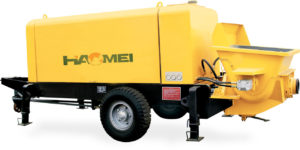a trailer concrete pump discharges concrete into a hopper on the back of the trailer concrete pump. Basically, the hopper is designed with a mesh grate through which the concrete falls to prevent any large chunks or rock from blocking the hoses of the trailer concrete pump. Also, the hopper is made with an auger, which churns the concrete to keep it liquid and flow-able.

As soon as the concrete gets into the hopper, it is sucked into a valve system in undersized strokes or intervals. While some of the concrete is sucked into the valve system, the concrete that flows before it is simultaneously plunged through the concrete pipe on the boom of the trailer concrete pump until it gets to the end of the concrete hose, where it is placed at the point it is needed.
Trailer concrete pumps are designed with different types of valve systems; ball-valves or s-valves, but essentially that is how a trailer pump pumps concrete. The sequence of pumping concrete using the pump goes on smoothly, as long as there are no blockages in the pump hoses and the hopper stays full.
The power for operation of the trailer concrete pump, on the hand, is generated by the engine, which compels the hydraulic pump system. Almost all roles of operation of the trailer concrete pump or mini concrete pump can be completed from the local reins escalated on the side of the pump. Optional radio remote and hand-held cable controls, which allow the concrete operator to use the pump from a remote distance, are also available.
According to published ratings and specifications, the trailer concrete pump is well-designed to securely pump wet concrete via a delivery system of hoses and pipes. Anyway, stability and safety of operating the trailer concrete pump is provided by the back and front triggers. Above all, safety of using the trailer or small concrete pumps depend on the skills of the operator.